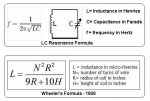Hello all
I've had some fun using bought transmitters receiver pairs to get two picaxes communicate. But I'd really like to try and make my own transmitter and receiver - but I'm struggling to find information to help.
I wonder if anyone can help with a few questions?
1. Is it a realistic thing to do? I'm not looking to create a walkie talkie with 1km range or anything - just want to build something which I can send a '1' or a '2' from one end of the kitchen table to the other.
2. How do I go about 'adding' my signal to the carrier wave? I know I could theoretically connect a 1mHz crystal to a dc power source with a switch, and every time I switch it on, I will create a frequency which a tuned radio will hear. But how would I go about modulating that frequency with a crystal? Or am I completely off track?
3. For the receiver - how would I calculate the number of windings I need and the capacitor value required to create a circuit which will resonate to the frequency of crystal I use? I presume it is possible to calculate what the resonant frequency would be of a particular size of coil and capacitor..but I can't find anything on Google about this. I've made a crystal radio before using a fixed coil and a variable capacitor, but I'd prefer to be able to build a circuit specifically aimed at a certain frequency, with a small trimmer presumably to fine tune.
If anyone could shed some light on this process, or point me to some links where I can learn more to help me work it out myself, I'd be grateful.
Many thanks
Toby
I've had some fun using bought transmitters receiver pairs to get two picaxes communicate. But I'd really like to try and make my own transmitter and receiver - but I'm struggling to find information to help.
I wonder if anyone can help with a few questions?
1. Is it a realistic thing to do? I'm not looking to create a walkie talkie with 1km range or anything - just want to build something which I can send a '1' or a '2' from one end of the kitchen table to the other.
2. How do I go about 'adding' my signal to the carrier wave? I know I could theoretically connect a 1mHz crystal to a dc power source with a switch, and every time I switch it on, I will create a frequency which a tuned radio will hear. But how would I go about modulating that frequency with a crystal? Or am I completely off track?
3. For the receiver - how would I calculate the number of windings I need and the capacitor value required to create a circuit which will resonate to the frequency of crystal I use? I presume it is possible to calculate what the resonant frequency would be of a particular size of coil and capacitor..but I can't find anything on Google about this. I've made a crystal radio before using a fixed coil and a variable capacitor, but I'd prefer to be able to build a circuit specifically aimed at a certain frequency, with a small trimmer presumably to fine tune.
If anyone could shed some light on this process, or point me to some links where I can learn more to help me work it out myself, I'd be grateful.
Many thanks
Toby

